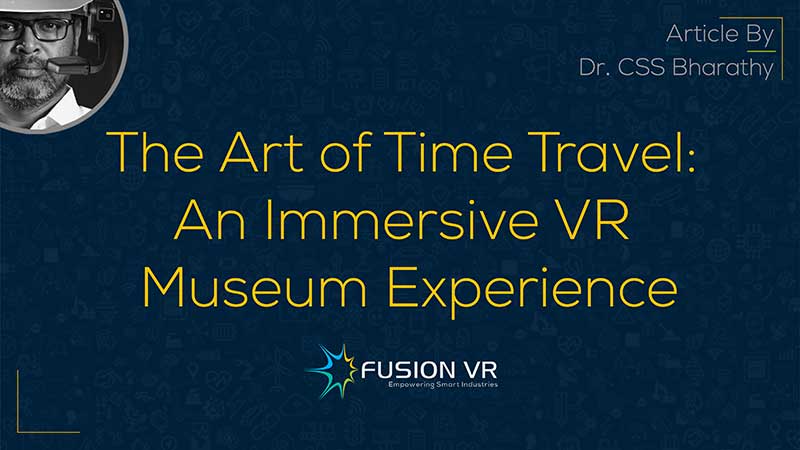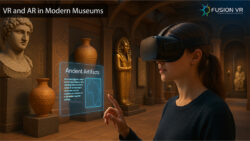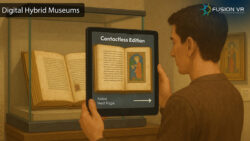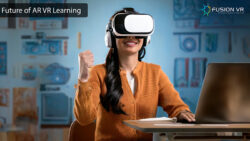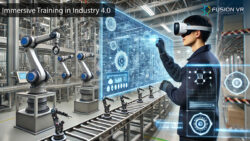Human beings treasure their personal memories the most and always yearn to go back to a time when they enjoyed the most. As most people call it, the good old times! Along the same lines is our curiosity about the past, what really happened and what it would have been like in that century or era. Our innate sense of curiosity has driven the growth and development of the human race, making it the most dominant species on the face of the earth.
Where would we be without it? There is a slew of audio-visual technologies that provide some kind of connection with the past and Virtual Reality is one. Virtual reality is a really cool technology that offers us an immersive way to go back in time and experience something magical and memorable.
I would say that time travel with virtual reality is both an art and a science. The question on your mind now is, how is time travel accomplished with VR?
Virtual reality, for anyone new to it, is actually a really cool way to “immerse” yourself in a digitally created 3D environment which can only be experienced using a specially designed headset. This headset completely covers the eyes, like a pair of dark goggles, cutting you off from the surrounding real environment.
The Impact of Virtual Reality in Museum Experiences
The headset has inbuilt optics and electronics that provide the VR experience. This sophisticated device then brings in front of your eyes the digitally created, hyper-realistic virtual world within which you can view as well as navigate around in all three dimensions.
Virtual reality has gained immense popularity in the gaming world and is gaining rapid traction in many fields of human activity, including the area of interactive digital museums or Museum 2.0. Traditionally, most museums have served as a bridge to the past for countless people in past generations. The archaeological exhibits in them shine a light on how ancient humans lived or how civilisations existed in Mohenjo Daro or the Egyptians on the banks of the Nile.
We have seen those in pictures and artistic recreations, coupled with our fertile imagination of what has once been. While this has helped us imagine ourselves travelling into that era, we have to agree that newer technologies in museums have been enabling us to go farther than any of our predecessors have been before.
An immersive VR museum experience leaves every visitor with an experience that matches that of a real experience. Travel has broadened everyone’s horizons and we seek more and more new experiences. Almost everyone today knows about a bucket list and has one.
There are many wonders of the world that are and may well be beyond the reach of many in their lifetime. VR makes the art of time travel possible for them in an instant. They may be able to hold conversations about their visit with a “real” traveller and feel as thrilled as the other one.
The Potential Impact of VR on Historical Education and Heritage Appreciation
Some of the world’s best immersive VR museum experiences are also quite easily accessible. Most of you know that the Louvre in Paris is home to Leonardo Da Vinci’s Mona Lisa painting. Did you know that on his 500th death anniversary, the Louvre inaugurated its first VR museum, called Mona Lisa: Beyond the Glass, which wished to honour and showcase Leonardo da Vinci’s vast capabilities as a true Renaissance genius who worked in art, science and engineering?
The VR show at this museum is helping virtual visitors discover through VR the details of his art that are either not obvious or hidden to the naked eye. The immersive museum experience is much more than a real visit as the Mona Lisa is a small painting and doesn’t allow the appreciation it deserves when viewed from a distance.
Closer home, with the recent screening of movies such as Ponniyin Selvan, there is a perceptible increase in the public interest in history. Though the movie brought to life the culture and daily life of people living in that dynasty, it would spur further development of VR solutions, content etc., that would present immersive experiences to the people.
Students, in particular, will relish the opportunity to see the great expeditions and conquests of the past, thereby developing a sense of pride and connection to their heritage.
These experiences are not only educational but also personally meaningful. The time travel virtual experience can be used to visit the famous historical places of the past such as the Taj Mahal, Red Fort, Old Delhi, Nalanda, Thanjavur Big Temple and many more within India and outside. The multiplicity of experiences possible is quite high and the ability to deliver immersive experiences is equally high with the latest advances in virtual reality and connectivity technologies such as 5G.
Design Philosophy for Creating Immersive VR Museum Experiences
A Virtual reality experience is actually more powerful than watching a reconstruction in a movie theatre or even something that is rendered in 3D. VR does a neat job of making you believe that you are actually there.
By bringing together a team of historians, artists, writers and VR technologists, we can weave a narrative and digitally recreate a scene or even a city from the past. We can obtain a truly immersive experience that feels completely real and totally satisfying. That is the amazing power of virtual reality.
Virtual reality is now being effectively integrated into today’s museums which is enabling its visitors to experience time travel. Museums are a perfect place for people, young and old, to enjoy the magic of the past. Most of them have transformed into interactive museums and corporate experience centres.
They have begun to integrate VR, enabling their transformation towards providing their patrons with a VR museum experience. Providing an experience of the art of time travel requires an expert blend of technical and aesthetic capabilities from a team of cross-functional experts working together. This effort to design involves several phases and many critical activities.
We are just scratching the surface of the transition to digital museums. Here’s a list of things any team engaged in creating the art of time travel in a VR museum should seriously consider as part of their design philosophy.
This is where the art meets the science of VR. First and foremost is that they do their utmost to create a sense of presence, interaction and engagement. The design of the VR environment should be visually appealing and highly realistic. The emphasis should be on incorporating high-quality graphics, texturing and lighting.
The ability to interact must be designed to include the liberty to touch, feel, manipulate and move objects directly or through simulation in the VR experience centre. Multiplayer capabilities should be inbuilt to enable enhanced interactive experience, particularly for the younger crowd. Education, along with entertainment, must be a high priority.
The legacy of each interactive experience rests on this ideal. Last and certainly not least is audio design, which is key to providing a complete sense of immersiveness and reality.
Fusion VR has been at the forefront of digital and immersive experiences for nearly two decades in India and is committed to enhancing museum visitors’ experience. We are spearheading the adoption of Museum 2.0 and championing the effort to make museums more modern and accessible to all.
The essential skills and design approaches detailed above are well within the capabilities of Fusion VR’s extensive team. Our expertise has played a pivotal role in the execution of prominent museum projects. It would be extremely easy to explore our website and reach out to our team for further engagement.
The most important aspect to take away from this blog is that we are not limited by technology to enjoy the art of time travel. The cost of devices, development of solutions and access to service providers are quite easy for museums who wish to transition to digital museums. The right efforts in this direction will enable us to deliver more immersive time travel experiences and rejuvenate the interest in museums as places of learning and unforgettable experiences.

